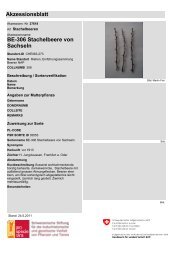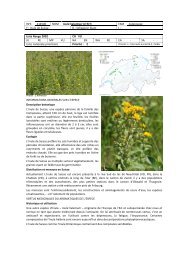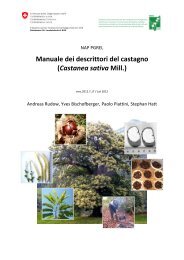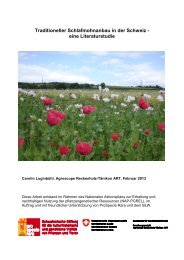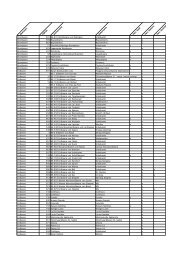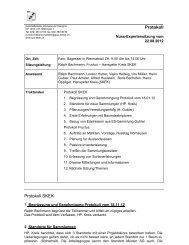Schlussbericht Crop Wild Relative
Schlussbericht Crop Wild Relative
Schlussbericht Crop Wild Relative
- TAGS
- schlussbericht
- crop
- wild
- relative
- bdn.ch
Erfolgreiche ePaper selbst erstellen
Machen Sie aus Ihren PDF Publikationen ein blätterbares Flipbook mit unserer einzigartigen Google optimierten e-Paper Software.
Promoting conservation: the SPIMED<br />
project in Sweden, Lithuania and<br />
Finland<br />
Arnica montana L. is one out of eight target taxa of<br />
the Nordic Genebank project "Spice and medicinal<br />
plants in the Nordic and Baltic countries. Strategies for<br />
conservation of genetic resources" (SPIMED). The project<br />
makes initiatives and efforts to conserve medicinal-<br />
and aromatic plants in the Nordic and Baltic<br />
countries, formulates conservation recommendations<br />
and will be finalised this year. Cultivation trials will be<br />
recommended as means to avoid exploitation of vulnerable<br />
populations.<br />
SPIMED included collecting and characterisation of<br />
accessions of the target species and collections of<br />
plants with a broad diversity have been established.<br />
Descriptors for the vegetative and generative plant<br />
parts of the species have been developed and<br />
tested. Collections of Arnica have been established<br />
and compared in Sweden, Lithuania and Finland. The<br />
characterization work was carried out at Svalöv in<br />
Sweden, in Vilnius in Lithuania and at Mikkeli in Finland.<br />
Threat: a problem of European scale<br />
A. montana L. has greatly declined European-wide due to loss of habitats and over-harvesting. In the<br />
Nordic region, changes in agriculture are major factors for the reduction. In Norway loss of habitat is<br />
the main problem and A. montana is now on the Norwegian Red List with status DC (declining/care<br />
demanding). If the changes in agriculture persist, the distribution will be even more reduced (Asdal,<br />
2005).<br />
The species is regarded as critically endangered in Belgium, Bosnia, Croatia and Luxembourg; endangered<br />
in Belarus and the Netherlands; vulnerable in Estonia, Germany, Latvia, Lithuania, Portugal<br />
and Romania; and near threatened in Denmark and Norway (TRAFFIC Network, 2005).<br />
European countries should develop general guidelines for sustainable collection of indigenous medicinal<br />
and aromatic plant species and promote their implementation (Lange, 1998). A. montana is<br />
an example of a threatened species for which specific guidelines for particular habitats and countries<br />
should be developed. Annual quotas of the amount of plant parts that may be harvested should<br />
be established.<br />
Literature cited<br />
Asdal, Å. 2005. Changes in grassland management and its effect on plant diversity. <strong>Crop</strong> wild relative<br />
3, 15-17<br />
Behrens, J., Schmitt, S. & Hamilton, A. WWF-UK Factsheets Arnica montana collected from http://<br />
www.wwf.org.uk/filelibrary/pdf/amontana.pdf<br />
Douglas, J. A., Smallfield, B. M., Burgess, E. J., Nige,l P. B, Anderson, R. E., Douglas M. H. & Glennie V.I.<br />
2004. Sequierpene lactones in Arnica montana: a rapid analytical method and effects of flower<br />
maturity and simulated mechanical harvesting on quality and yield. Planta Med. 70, 166-170.<br />
George Thieme Verlag, Stuttgart, New York<br />
Labokas, J., 1999. In situ conservation of medicinal plants and small fruits in Lithuania. Botanica<br />
Lithuanica. Suppl. 2: 167-170<br />
Lange, D. 1998. Europe’s medicinal and aromatic plants: their use, trade and conservation. A TRAF-<br />
FIC Species in Danger Report<br />
Radusiene, J. 2004. Trade, use and conservation of medicinal and aromatic plants in Lithuania. Acta<br />
Horticulturae, No. 629: 31-37<br />
TRAFFIC Network http://www.traffic.org/<br />
www.pgrforum.org



